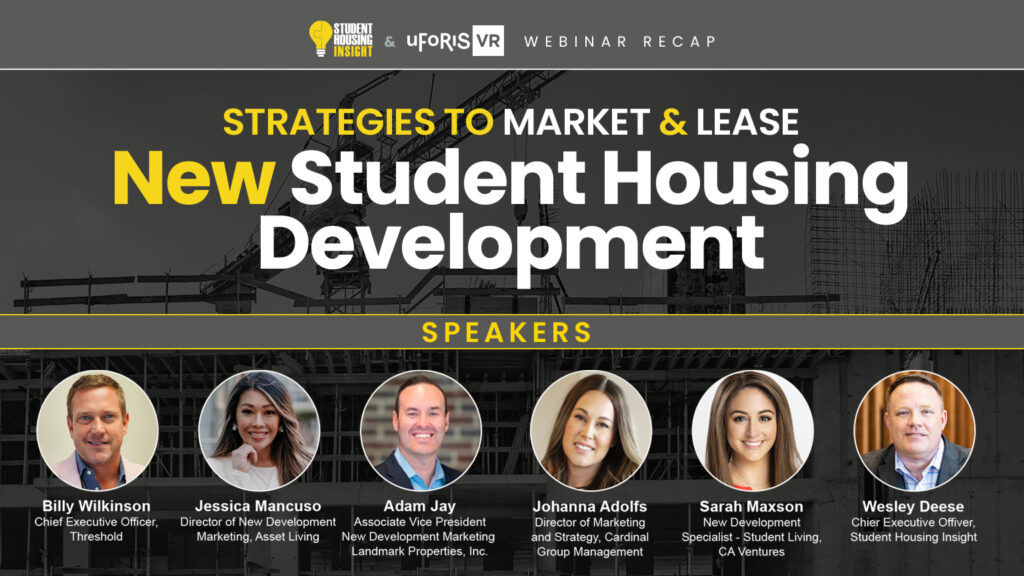Introduction
In the dynamic world of student housing, staying ahead of the game requires innovative marketing and leasing strategies. Recently, Student Housing Insight partnered with uForis VR to host an insightful webinar featuring industry experts who shared their experiences and insights on effectively marketing and leasing new developments. In this blog post, we’ll recap the key takeaways from the webinar and explore the strategies discussed by the esteemed panel of speakers.
The webinar was moderated by Wesley Deese, CEO of Student Housing Insight, and featured the following speakers: Billy Wilkinson (CEO, Threshold), Adam Jay (Associate Vice President New Development Marketing, Landmark Properties), Johanna Adolfs (Director of Marketing & Strategy, Cardinal Group Management), and Sarah Maxson (New Development–Specialist, Student Housing, CA Ventures). Honorable mention to Jessica Mancuso (Director of New Development Marketing, Asset Living) who experienced technical difficulties and was unable to join.
Webinar Recap
Understanding the Target Demographic:
The panel emphasized the importance of understanding the unique characteristics and preferences of the target demographic. While college students are a common target, there are regional and university-specific differences to consider. Johanna says, “Anticipate a longer timeline than you originally expect. Sometimes Cardinal is 2 years out from delivery”. Tailoring marketing strategies to effectively communicate the product offering to the target audience is key.
Timelines and Marketing Budgets:
The timing of marketing initiatives and budget allocation varies depending on the university and local market conditions. Some universities may require marketing to start as early as the spring semester, while others can afford a later start. Johanna referenced “selling a dream” so it’s important to start early, and have the budget to start building awareness for a successful lease-up. The panel highlighted the need for engaging marketing materials that stand out in a content-overloaded world and the significance of understanding who plays a role in decision-making and reflecting that into the timeline as an additional buffer.
New Development Marketing Budget vs. Stabilized Budget:
New developments typically require larger marketing budgets compared to stabilized properties. Adam suggested a new development budget is 3-6x more than a stabilized communities budget because of how much additional advertising you need to invest in. The goal is to attract high-quality renters and maximize rent revenue during the lease-up phase. Marketing efforts during this stage focus on selling a dream or story through renderings, brand awareness, and building relationships with prospective students.
Digital Marketing and Website Launch:
Digital marketing plays a crucial role in attracting and engaging student renters. The panel recommended launching a website as soon as the brand identity is available. Billy says, “Starting with a landing page helps generate early leads, while high-quality renderings, floor plans, and comprehensive website content provide students with a holistic experience and can come closer to pre-leasing”.. SEO and PPC campaigns should commence 2-3 months before pre-leasing, with campaigns and budgets tailored to lease-up goals. Sarah suggests these efforts do take longer to stabilize and should really focus on what specific student you’re targeting and create content for them.
Creating Compelling Content and Virtual Tours:
To capture the interest of prospective students, it is essential to create specific and engaging content. Lifestyle photography and videos that reflect the desired lifestyle resonate well with the target audience. Virtual tours have become widely acceptable and help students visualize the living experience. In uForis’ Designing for the Future Report students share their preferences on rendering staging such as time of day and if virtual people are included. Students prefer to see renderings without virtual people and Billy echoes this statement with knowing students see it as more of a distraction to the space than value. Sarah has seen a lot of success in leasing into lifestyle videography when starting paid lease-up campaigns because it gives the propsect a sense of experience the community will bring.
On-the-Ground Marketing and Building Brand Awareness:
The timing of on-the-ground marketing activities depends on the specific market and university. Initiating brand awareness campaigns 18 months in advance of the first move-in is ideal. The panel suggested utilizing campus events, housing fairs, and creative opportunities to engage with students. Leveraging social media and popular trends among college students can also enhance brand visibility.
Temporary Leasing Offices and Alternative Spaces:
When faced with space or budget constraints, alternative spaces can be utilized creatively. Temporary leasing offices should aim to provide a similar experience to the actual development, showcasing brand elements and creating a sense of trust and excitement. WeWork spaces and alternative options, like Oot Box, can serve as viable alternatives for engaging prospects. CA Ventures has used Oot Box and leveraged the outside to attract students to use it as a photo prop for social media in the day/evening based on how they have styled it. Landmark has also utilized WeWork spaces in certain markets while the leasing office was being built out.
Building the Ideal Lease-Up Team:
Lease-up teams require individuals with specific personalities and skill sets. Outgoing team members who enjoy engaging with vendors, businesses, and students are essential. They should possess a strong work ethic, flexibility, and the ability to build relationships. Student involvement in the leasing team can bring a valuable perspective and help amplify the community’s message across campus.
Conclusion
The webinar provided valuable insights into the effective marketing and leasing of new student housing developments. Understanding the target demographic, developing comprehensive marketing plans, leveraging digital platforms, and creating engaging content are critical factors for successful lease-up campaigns. Building brand awareness, establishing trust, and assembling the right lease-up team contribute to achieving leasing goals. By implementing the strategies discussed in the webinar, student housing professionals can optimize their marketing efforts and ensure a successful lease-up process.
To access the complete report and dive deeper into the discussed strategies, download the third-year Designing for the Future 2023 report here and watch a replay of the webinar here.
Remember, staying adaptable and creative is essential in the ever-evolving student housing market.

